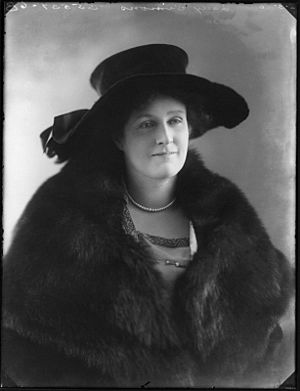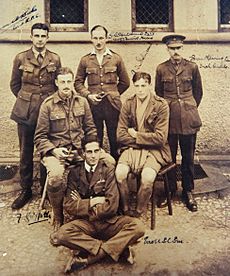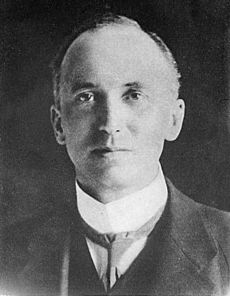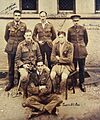Kathleen Simon, Viscountess Simon facts for kids
Kathleen Rochard Simon, Viscountess Simon (born 23 September 1869 – died 27 March 1955) was an Irish activist who fought against slavery. She was inspired to learn about slavery after living in Tennessee with her first husband. After he passed away, she moved back to London and joined the movement to end slavery.
With her second husband, Sir John Simon, she worked hard to stop all kinds of forced labor. She traveled and spoke a lot throughout her life. Kathleen Simon was well-known for her dedication to ending slavery and racial discrimination. She was even given a special honor, becoming a Dame Commander of the British Empire.
Contents
Her Early Life
Kathleen Simon was born in Rathmines, South Dublin, Ireland. Her family, the Harveys of Kyle, owned land near Enniscorthy, County Wexford. Her parents, Frances and Francis Harvey, taught their daughters to love freedom and hate slavery.
She went to several schools in Dublin and also had private lessons. Kathleen trained as a nurse and married an Irish doctor, Thomas Manning, on 21 February 1885. They moved to the United States and lived in Tennessee. They had one son, Brian O'Donoghue Manning.
After her first husband died, Kathleen Manning moved to London. She started working as a midwife in the East End of the city. Because midwifery alone didn't pay enough, she also became a governess for the children of Sir John Simon, who was a widower.
During the First World War, her son Brian served in the Irish Guards. When he became a prisoner of war, she asked Sir John for help. Kathleen married Sir John Simon on 18 December 1917 in France. She became known as Lady Simon and stayed in France to work with the Red Cross.
Her Fight for Justice
When Kathleen Manning lived in Tennessee, she saw discrimination against a young African-American girl named Amanda. This experience deeply affected her. After moving to London, she joined the Anti-Slavery and Aborigines' Protection Society.
Lady Simon also supported the Irish republican cause during the Irish War of Independence. She even tried to get her husband to join her in supporting it. However, she was not very popular with high society. The Prime Minister, Neville Chamberlain, once wondered why Sir John married her, saying she didn't "fit the part of a grande dame!"
Ending Slavery
In 1927, Lady Simon and Violet Bonham Carter decided to support a convention by the League of Nations. This convention stated that "no colour barrier should be erected" to stop native people from getting jobs they were good at.
Lady Simon and Sir John wrote a report about slavery happening in the colony of Sierra Leone. This report was published in The Times newspaper. In 1928, Lady Simon showed her interest in the rights of African Americans again. She attended the dedication of the Wilberforce Monument with Walter Francis White, the president of the NAACP.
Throughout the 1920s, Lady Simon researched chattel slavery around the world. She believed that more than six million people were "living in bondage." Her very successful book, called Slavery, was published in 1929. She dedicated it to "Amanda of Tennessee," the girl she met in Tennessee.
The Sunday Times called her book a "startling indictment of modern civilisation." The Daily News wrote that "this country cannot wash its hands of responsibility." W. E. B. Du Bois, a famous writer and activist, reviewed her study and liked it. Their discussions about the book led to a lasting friendship. Lady Simon remained a strong supporter of the Anti-Slavery and Aborigines' Protection Society.
Lady Simon also caused some embarrassment for supporters of Haile Selassie I, the Emperor of Ethiopia. Before the Second Italo–Ethiopian War, she revealed that he owned slaves. She claimed that Benito Mussolini had convinced her he would try to end slavery in Ethiopia.
Fighting Other Forced Labor
Lady Simon was also very concerned about less obvious forms of forced labor. These included indentured labor, where people work to pay off a debt, and Mui tsai, which were domestically enslaved girls in China.
She publicly spoke out against using forced labor in East Africa. She believed it went against the principles of the League of Nations. For many years, she fought for the freedom of Mui tsai girls. She worked with MPs Edith Picton-Turbervill and Eleanor Rathbone on this issue.
Later Years
In 1933, Lady Simon was honored for her hard work. She was appointed a Dame Commander of the Order of the British Empire. As part of her campaign, she traveled a lot both in her country and abroad. She gave speeches and raised money. In 1934 alone, she spoke to 10,000 people.
Three years later, Sir John became Chancellor of the Exchequer, a very important government job. The couple moved to 11 Downing Street. In the years just before the Second World War, Lady Simon criticized the Nazi regime. She also supported Zionism, the movement for a Jewish homeland.
In April 1940, even though she was struggling with severe osteoarthritis, she hosted a meeting at 11 Downing Street. There, she stressed how important it was to prepare people in the British Empire for home rule (self-governance). She also spoke out against racial discrimination. That same year, her husband was given the title Viscount Simon, and she became Viscountess Simon.
Her Death
Lady Simon's husband passed away in 1954. She died at her home in Golders Green in 1955. She was cremated at Golders Green Crematorium.
Images for kids






